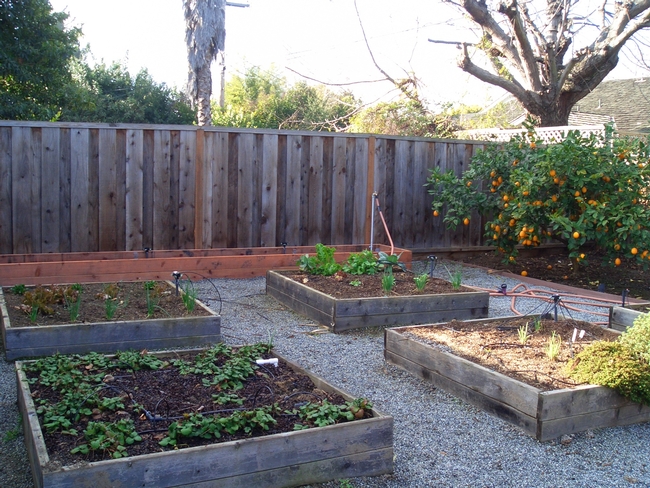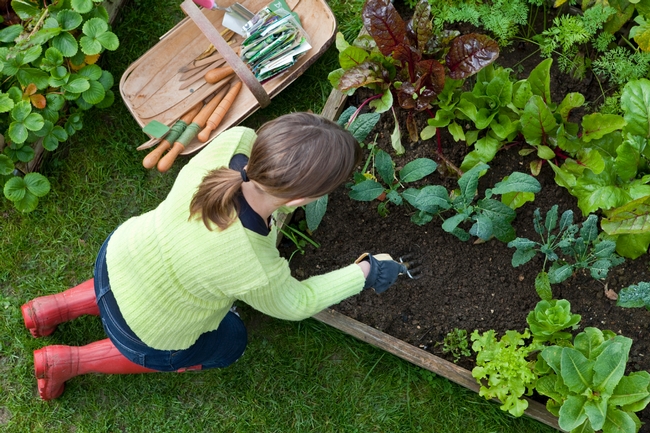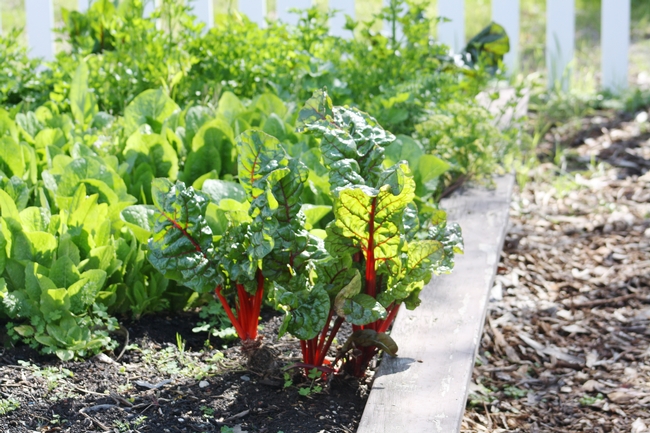- Author: Melissa G. Womack
- Author: Nancy Grove, UCCE Master Gardener of San Mateo and San Francisco counties
Is it possible to grow a vegetable garden when water resources are scarce and water rationing could be imposed? Water responsibly, plant carefully, and select fruit and vegetable varieties that are drought tolerant. All of these sustainable gardening practices require less water – and help ensure your family has access to a variety of nutrient rich foods.
Ten simple drought tips to reduce water use in your backyard garden
- Planting time
Plant earlier in spring and later in fall. Planting earlier in the spring season takes advantage of the warm weather and reduces exposure to high mid-summer temperatures. Planting later in the fall minimizes the use of supplemental water and takes advantage of seasonal rains to establish plants. For example, tomatoes and other nightshade crops such as peppers and eggplants, should not be planted until soil temperatures reach 55 degrees. With a warm spring this could be as early as mid-April. Remember to always use a soil thermometer for accurate soil temperature readings.
- Mulch, mulch, mulch!
A 3- to 4-inch layer of mulch can reduce watering needs by as much as 50 percent. Mulch reduces water evaporation and keeps soil temperatures down during hot summer months. Grass clippings, dried leaves, pine needles, straw and shredded bark are all examples of natural mulches which can be used to cover the soil. Hay is not recommended because it contains seeds, which yields weeds and can become a problematic option. Raised garden beds help retain water better than gardens planted in open soil.
Raised garden beds help retain water better than gardens planted in open soil. - Enclosed spaces
Gardens planted in enclosed spaces, for example a raised garden bed, retain water better than gardens planted in open soil. Plant seeds and transplants in a hexagonal "off-set" pattern rather than in straight rows. A hexagonal arrangement groups plants closer together, which provides shade from leaves, keeping soil cool and water from evaporating. - Companion planting
Companion planting is the practice of grouping crops together for mutual benefit. The Native American “three sisters” approach of planting corn, beans and squash together are the perfect example of companion planting. Tall cornstalks provide a structural support for the climbing beans, the beans return nitrogen back into the soil, and the squash spreads across the soil acting as a mulch and keeping the soil cool. - Watering times
The best time to water your garden is in the late evening and early morning hours, typically between 9 p.m. and 6 a.m. The cooler morning temperature and limited wind reduced water evaporation rates. - Water efficiently
Overhead watering with a sprinkler system is not as efficient as drip irrigation. Compared to overhead sprinklers - drip systems can reduce water usage by up to half. Install a drip irrigation system, grouping plants with similar water needs together on one drip irrigation line. Drip irrigation systems are relatively easy to install for most do-it-yourself homeowners. The UC Division of Agriculture and Natural Resources book Drip Irrigation in the Home Landscape is a great reference on the materials, design and installation of a drip system. Select the correct size garden for your family, to reduce waste from overproduction.
Select the correct size garden for your family, to reduce waste from overproduction. - Control Weeds!
Pesky weeds compete for valuable water, sunshine and soil nutrients in your garden. Remove weeds before they have an opportunity to flower or spread. Visit the UC Integrated Pest Management website for tips on controlling weeds to identify recommendations for specific weed species. - Drought Resistant Crops
Purchase varieties of fruits and vegetable that do well in hot and dry climates. Many heirloom varieties from Mediterranean regions are prized for being drought tolerant. Smaller varieties bred for containers often produce a more bountiful yield per plant than standard varieties. Avoid water hogs! Some favorite water-efficient edibles from UCCE Master Gardeners include: asparagus, chard, eggplant, mustard greens, peppers, roma tomatoes, and California native strawberries. Check with a local UCCE Master Gardener Program about which varieties are recommended for your zone. - Peak water times
Fruit and vegetables have critical periods for increased water demands. For most plants once they become established watering times and amounts can be reduced until the flowering or fruit setting process begins. An increased amount of water should be reintroduced during this time. After this initial period of fruit set water can slowly be reduced again. In some cases, reducing water can improve the flavors of your harvest (think, dry-farmed tomatoes)! - Garden size
Determine the amount of fruits and vegetables needed to feed your family, does your family have two, four, or eight members? If you overproduced and wasted crops last year - decrease the amount of plants this year. Set up a garden exchange in your neighborhood so everyone grows less but still has a great variety!
The University of California Master Gardener Program extends to the public free UC research-based information about home horticulture and pest management. In exchange for the training and materials received from the University of California, Master Gardeners perform volunteer services in a myriad of venues. If you are interested in becoming a certified UC Master Gardener contact your local UC Cooperative Extension office.





Thanks,
Joe Boldt
Master Gardener, San Diego
Patricia Silva
There are a couple of reasons why Roma tomatoes are on the list. Roma tomatoes are a type of paste tomato - meaning they have a denser fruit wall and less water. This is what makes them great for sauces, ketchup and canning. Roma tomatoes are determinate meaning that the plant grows to its full size and then stops. Indeterminate tomato varieties often have more vegetative growth than determinate ones and therefore typically need more water. The other tenant of a determinate tomato plant is that the fruit crop ripens together instead of the fruit ripening over the course of the season. Once you’ve harvested your Roma crop, you can pull out the plant and compost it – there is no further need to water it.
Thanks, Melissa
Emma
Impressive write-up, indeed!
- Artificial Grass GB
This past summer, we did not use a single drop of city water for any of our 4x12 raised beds, nor the 4 wildflower beds/2-dozen potted veggies (to bring indoors, fully mature and producing, over winter) or any of our indoor plants.
Clive
DIY Garden UK
Building raised beds today. With what I have on hand. I was thinking of horizontal gardening in palettes for strawberries and lettuce
Any tips?